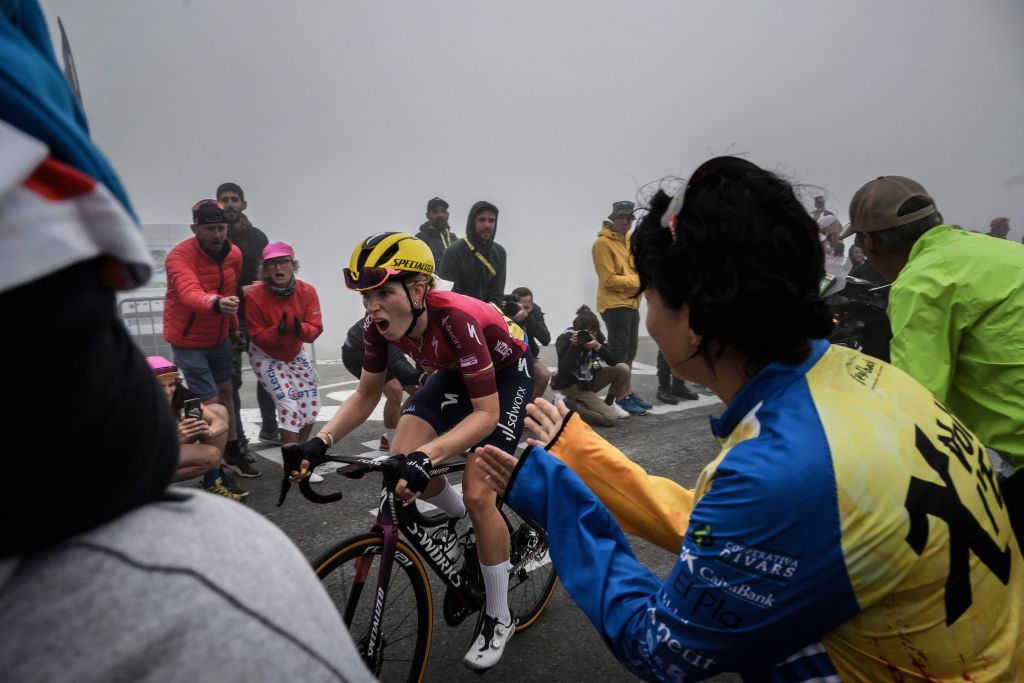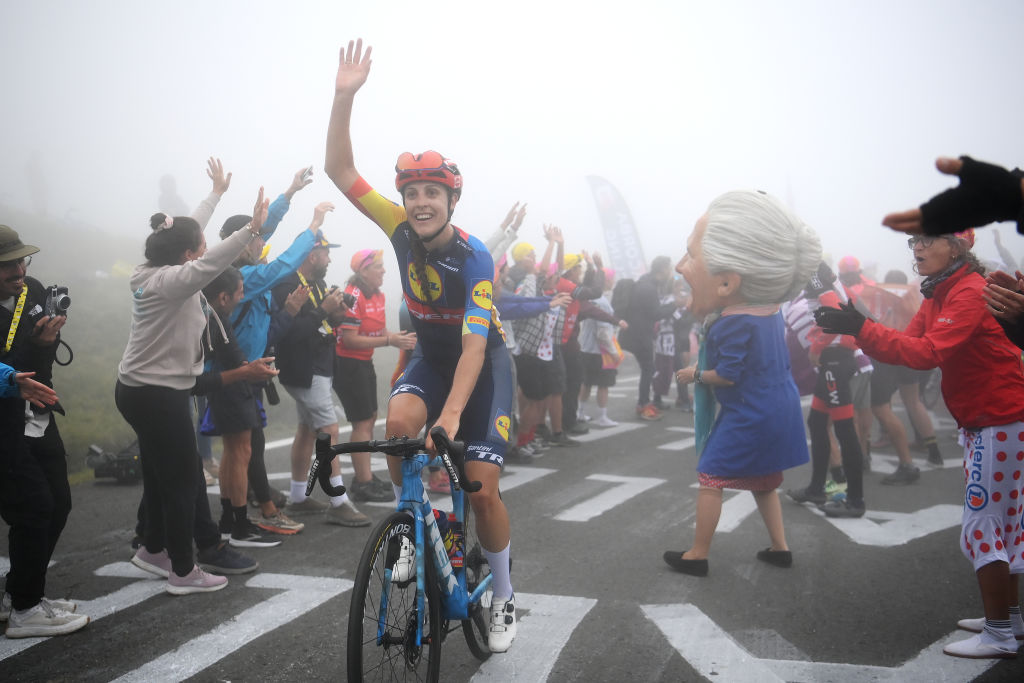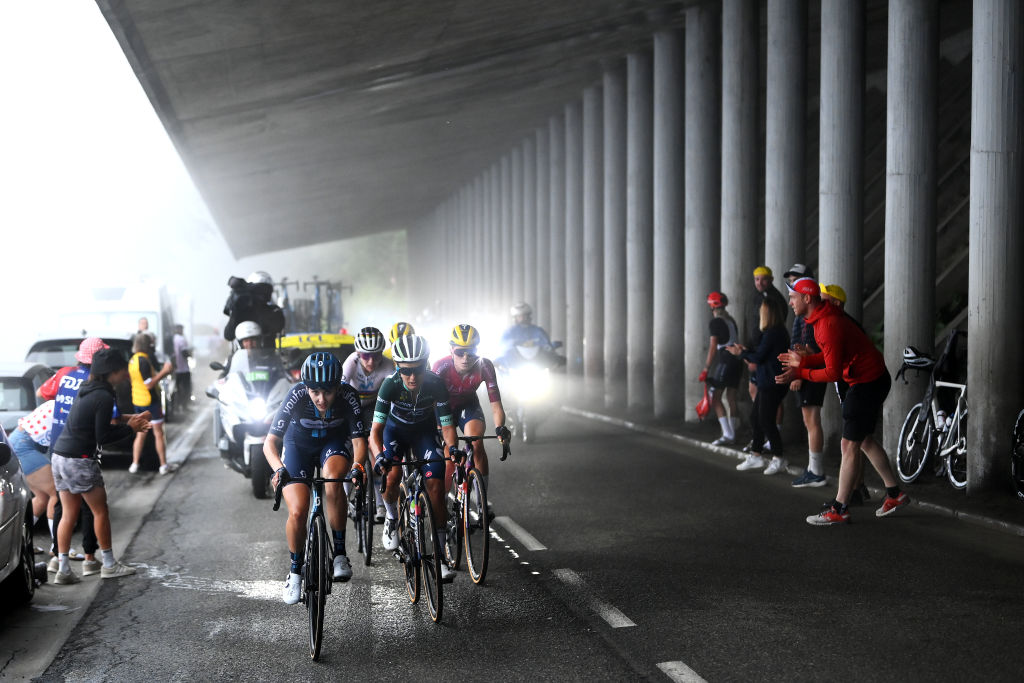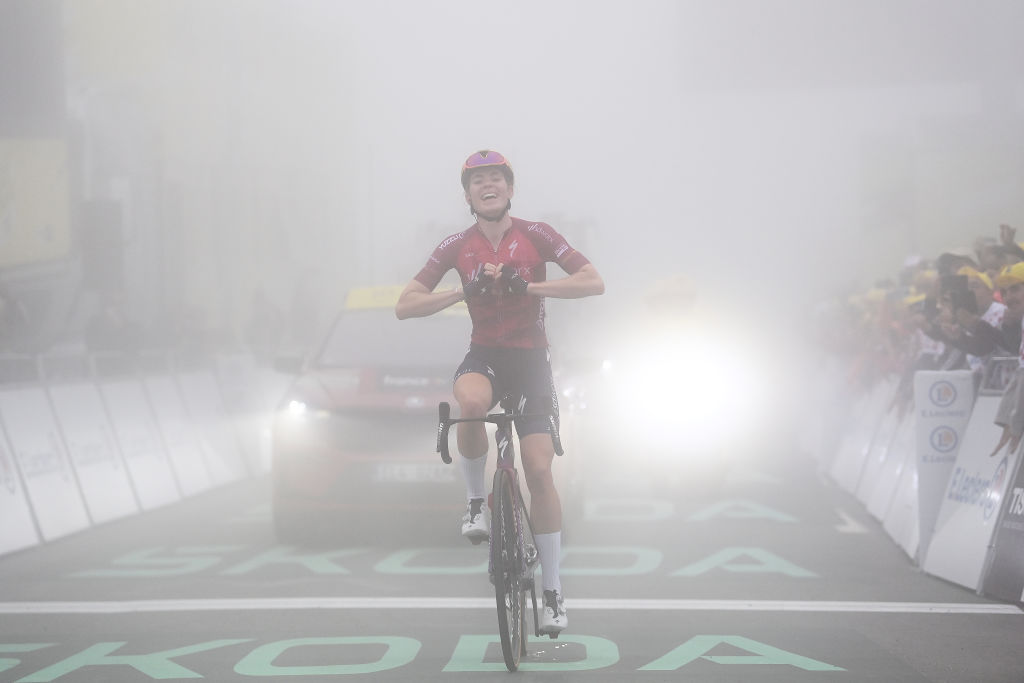




I am writing this report on what it was like at the much-anticipated queen stage of the Tour de France Femmes from the back seat of our rental car as we drive down the Col du Tourmalet in pitch-black darkness. The start of the day was a far cry from the frenetic conclusion – with its heated GC battle and the mystical touch added by mother nature – as it all began with a lie-in and relaxed morning because of the very late start to stage 7.
Eventually, however, my Cyclingnews colleague Kirsten Frattini, Cycling Weekly’s Tom Davidson, and I drove to Lannemezan. The small town on the foothills of the Pyrénées was filled to the brim by the Tour circus of technical crews, the advertisement caravan, spectators who wanted to drink in the atmosphere of a stage start, media, and of course the riders and teams themselves. Accredited vehicles were parked practically anywhere there was any space.
We got takeaway pizzas for a late lunch, and I went back to our car, sitting down in the shade of a tree to eat my meal. While there, the Movistar team bus and cars drove through at speed as if they were carrying royalty – which, in the cycling world, they kind of were.
When my colleagues had finished their scheduled interviews – stay tuned to find out who they talked to – we made our way south from the start town towards Bagnères-de-Bigorre and Sainte-Marie-de-Campan where the Tourmalet climb started. Appreciating the car’s air conditioning after the sweltering heat of Lannemezan, we passed several cyclists who were clearly also on their way to see the race.
Turning onto the race route at the foot of the Col du Tourmalet, we were blown away by the crowds. The road through the small mountain village was packed with spectators even though the race was still hours away. For the French people, this race isn’t the Tour de France Femmes – it’s simply the Tour de France and they came out in force to support the race.
The first five kilometres, rising gradually along the valley above the town, were less crowded, but once the gradient kicked up there were spectators everywhere. Some had walked up a few kilometres, others had driven up in campers the night before, including many cycling-crazed Belgian and Dutch fans. Waving and honking, we drove further and further up, passing cyclists who took the chance to climb the Tourmalet on race day.
One such group of cyclists were the young French girls and women of “Elles arrivent” who have been riding on the route ahead of the race each day since Clermont-Ferrand and were now on their way up the Col d'Aspin and Col du Tourmalet in their striking blue kit.
Into the mist

Eventually, we entered the shroud of mist that hung over the Pyrénées this race day, making visibility extremely limited. Passing through avalanche protection galleries, we reached the resort town of La Mongie and the press centre for the day. Having volunteered for the job of going to the finish to collect quotes from the riders, I was soon on my way again, happy that the mist obscured the very limited 1970s concrete charm of La Mongie.
Having carefully packed my rucksack with everything I might need at 2115 metres (and quite a few things I didn’t need, it turned out), I faced a 20-minute walk to the chairlift that would take me to the Col du Tourmalet. And since this walk wasn’t on the main road, I soon left the bustle of La Mongie behind.
Walking through the mist along the L’Adour du Tourmalet mountain stream, I felt almost meditative, as if I was all alone in this mountain world – which in turn made me worry whether I was walking in the right direction. Eventually, I saw a few people who confirmed I was on the right path and after hearing cowbells through the mist, and walking past the cows they were attached to, I could finally make out the hum of the chairlift.
For someone not exactly comfortable with heights, this wasn’t something I had been looking forward to – especially since the race organisation had been using the term cable car instead. But needs must, and a translation error wasn’t going to put me off. In this case, the mist helped since I couldn’t see much anyway.
Finally, the main road to the Tourmalet pass came into view below me, barriers, spectators, messages on the road and all, 400 metres from the finish. I glided over the road once more on its final hairpins before exiting the chairlift and walking downhill to the finish.
Locating the press area and those of my colleagues who had also gone to the finish, some by car, some by chairlift like me, and others walking up all the way from La Mongie, discussions soon started about the race. Kasia Niewiadoma (Canyon-SRAM), Annemiek van Vleuten (Movistar), and Demi Vollering (Team SD Worx) had left the rest of the peloton behind and were steadily riding towards the Col d’Aspin where Niewiadoma won the mountain sprint before throwing herself down the descent.
Vollering, it transpired, told Van Vleuten that she wasn’t going to work to bring the Polish climber back, and Van Vleuten called the bluff and sat up, too. Opinions in the press corps were divided on whether Niewiadoma had a chance to finish solo or not, but what everyone could agree on was that her move was full of panache, perfectly matching the “Allez Allez Allez” on the back of her jersey.
When Van Vleuten and Vollering were caught by the group behind, Marlen Reusser (SD Worx) took over the chase on those first five kilometres of the climb. When the Swiss champion swung off 12.2 km from the top, Niewiadoma was only eight seconds ahead, but as there was nobody else who wanted to keep the pace high, the Polish rider’s gap went out again.
The gap was 44 seconds when Juliette Labous (Team DSM-Firmenich) accelerated 9.3 kilometres from the finish, a move that was quickly recognised by the press corps as a bid to distance other GC top-10 contenders. When Vollering attacked, quickly passing Niewiadoma, I said that Yara Kastelijn (Fenix-Deceuninck) might hold on to the mountain jersey – but I was quickly corrected as it was pointed out that Niewiadoma only needed to finish in the top three to take the polka-dots.
I thought this unlikely as she had been on the attack for some time and would surely get passed by other riders as well; but as it was, Niewiadoma finished second on the stage to take the polka-dots and the red number for the most combative rider. Sorry, Kasia, I shouldn’t have doubted you.
A day to stand out in history

Here at the top, the mist wasn’t a mist, but simply a cloud, and it wasn’t raining as such, it was just a bit wet. Drops of water quickly adorned everyone’s hair, and I conducted most of my interviews with my glasses being partially fogged up due to the combination of the weather and a facemask, sending audio files down the mountain to the Cyclingnews blimp in a continuous stream.
While Vollering was getting closer to the finish, riding to the stage win and yellow jersey, a quick walk across the road took me to the port-a-loos and then to the restaurant where I bought a can of Orangina, the excellent French carbonated beverage that has fuelled my Tour de France Femmes reporting.
On the way back, I just had time to take snapshots of the monument to Jacques Goddet and Le Géant, the statue of a rider climbing the Tourmalet “en danseuse”, out of the saddle and looking up towards the finish, before heading back to the mixed zone just around the corner from the finish.
After crossing the line, Vollering was immediately whisked off to do her stage winner’s duties, so I only saw her much later when she went through the mixed zone after the podium presentation. The same was true for Niewiadoma; the first rider I set eyes on was world champion Van Vleuten.
It hadn’t been a good day for the defending Tour de France Femmes champion, and her sports director Jorge Sanz gave her a heartfelt hug before the Movistar press officer handed her a bottle of orange juice and she began answering questions, a huddle of cameras and microphones immediately forming around her. The orange juice was quickly gulped down between answers and replaced by what looked like a vegetable smoothie that went the same way just as fast.
Other riders arrived at the top in ones and twos, the time gaps being measured in minutes after a hard stage. Team staff members took care of them, setting up turbo trainers for warm-downs, handing out recovery drinks, towels, and jackets, and in some cases taking photos to remember a day that will stand out in women’s cycling history in no small part due to the heroic, black-and-white character the mist gave the race. Riders continued to appear seemingly out of nowhere to be cheered on by the crowds, whether they were stage winner Vollering or lanterne rouge Marjolein van’t Geloof (Human Powered Health).
With all interviews done and the crowds dispersing, it was time for me to head down the mountain again. I wasn’t exactly looking forward to this 4.5-kilometre hike, especially as it was quickly getting dark and the general dampness had been replaced by actual rain. But I hadn’t even made it to the 50-metre sign before a car stopped, recognising the thumb I had stretched out more because that’s a thing you do when walking down a road than in the genuine hope I would be able to hitch a ride. I got into the car of a French couple and their teenage daughter who agreed to take me back to La Mongie.
When I asked them in my broken French whether they were from the area, they replied that they weren’t. They were from Normandie and had driven down to the Pyrénées on Friday in order to be able to see the race on the most iconic climb of the Pyrénées, if not all of France. And when I asked whether they’d be in Pau for the finishing time trial, they said they’d instead drive back home on Sunday. That is the dedication that the Tour de France – men's or women's – lives and thrives on. I hope that this day was just a beginning and that the Tour de France Femmes will visit many more iconic climbs sooner rather than later.







